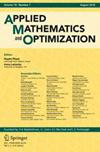Finite Element Approximation of Lyapunov Equations Related to Parabolic Stochastic PDEs
Abstract
A numerical analysis for the fully discrete approximation of an operator Lyapunov equation related to linear stochastic partial differential equations (SPDEs) driven by multiplicative noise is considered. The discretization of the Lyapunov equation in space is given by finite elements and in time by a semiimplicit Euler scheme. The main result is the derivation of the rate of convergence in operator norm. Moreover, it is shown that the solution of the equation provides a representation of a quadratic and path dependent functional of the SPDE solution. This fact yields a deterministic numerical method to compute such functionals. As a secondary result, weak error rates are established for a fully discrete finite element approximation of the SPDE with respect to this functional. This is obtained as a consequence of the approximation analysis of the Lyapunov equation. It is the first weak convergence analysis for fully discrete finite element approximations of SPDEs driven by multiplicative noise that obtains double the strong rate of convergence, especially for path dependent functionals and smooth spatial noise. Numerical experiments illustrate the results empirically, and it is demonstrated that the deterministic method has advantages over Monte Carlo sampling in a stability context.

 求助内容:
求助内容: 应助结果提醒方式:
应助结果提醒方式:


